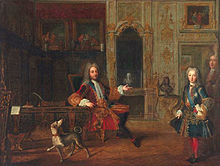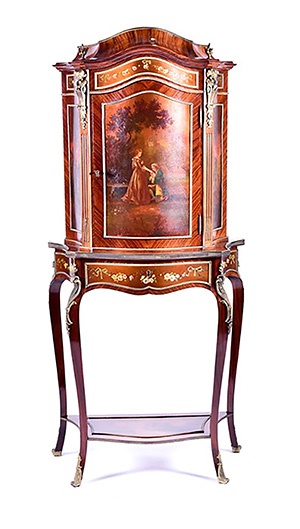How do I Identify Louis XV Furniture?
The reign of Louis XV is regarded by many as the Golden Age of French furniture
03/02/2022
The House of Bourbon ruled France for almost two centuries, during which period they significantly influenced fashion and décor. Each King contributed their own distinctive style to the furniture, music and decorative arts of his time.
The Three Kings
Louis XIV transformed his father’s hunting pavilion into Versailles Palace, which is now considered one of the greatest achievements in French 17thcentury art. Spanning over 63,000m2, Louis needed a staff of 5000 to maintain his “chateau”. He declared it compulsory that any guests attending events at his palace be well dressed, and he even went so far as to insist on a new outfit for each occasion. Several fairy tales were inspired by this newly enforced fashion etiquette.
The reign of Louis XV is regarded by many as the Golden Age of French furniture. Influenced by scandal and royal mistresses, it was a period of great creativity - designed for comfort.

Louis XV
Following the French Revolution of 1789 and the execution of Louis XVI, the early 19th century was the last great period in French furniture making. As Louis XIV, Louis XV and Louis XVI styles evolved organically, it is worth noting that some pieces often exhibit characteristics of more than one era. Let’s take a closer look at the greatest of all French furniture periods.

A French late 19th century Louis XV style ormolu mounted vitrine
Sold at Dawsons for £5,000
Louis XV
There are three discernible periods to consider. The Regency (1715 – 1730) when Louis XV was too young to rule, and furniture continued to follow the Louis XIV style. The first style (roughly 1730 – 1750) in the rocaille fashion, and then the final era (roughly 1750 – 1774) which was a reaction against rocaille.

Louis XV with the regent, Philippe of Orléans
The Louis XV period was one inspired by passion, romance and women. In 1725 Louis married the Polish princess, Marie Leszczyńska, they went on to have ten children, of which six survived until adulthood. From 1732 the King had several mistresses, most notably and influential were Madame de Pompadour and Madame du Barry.
He extensively redesigned interiors at Versailles to create smaller apartments or salons, which required intimate, versatile and elegant furnishings. The increased feminine power and influence of this period is reflected in the design and tastes. Chair armrests were shortened to accommodate women and their fuller skirts and furniture suited to ladies, such as vanities and dressing tables, became more in demand.
A Louis XV style Vernis Martin cabinet
Characteristics of Louis XV furniture
Connecting life with nature in the Rococo style, less fanciful than the previous baroque period, furniture became asymmetrical and more ornate, whilst moderate usage of curved lines was a guiding principle.
The most notable characteristic of Louis XV furniture is the curved cabriole style legs on tables, chairs and sofas, often carved with designs and terminating with a delicate foot. Comfort was king, and pieces like the chaise longue came into fashion.
Louis XV preferred furniture that suited conversation, which is why Jean-Baptiste Tilliard created the bergère. Elaborately decorated in such a way that it was clearly meant to be free standing and portable chair, rather than placed against a wall. Chairs became smaller with shorter armrests, curved seats with padding/springs for comfort, and gently angled with rounded or cartouche backs and carved wooden frames.
Decorative motifs in the form of symbols of love, stylised flowers, acanthus leaves, irregular scallop shells, birds/doves, dolphins, rosettes and cartouches were most popular. Asian influences of chinoiserie and other exotic styles are also evident in this era. Hidden drawers and secret compartments emerged to become quite desirable features.
Fabrics used were mostly floral arrangements in vibrant colours, often with lace accents. Fruit woods and rosewood replaced darker woods. Materials continued to communicate wealth and included bronze doré (ormolu) mounts, mother-of-pearl, precious metals and ivory. Extravagant carvings, wood veneers, marquetry, painted or lacquered wood, gilt accents and high polish finishes, with marble and porcelain tabletops.
A large Louis XV style serpentine front kingwood vitrine cabinet
Tips for avoiding modern reproduction pieces
- Look at the joints for indications of hand cutting vs machine cutting. Dovetail joints made by hand wouldn’t be exactly even, which is a good indication that the piece was made before 1860.
- Examine the piece carefully for imperfections, signs of any nicks or cuts which could indicate hand operated tool usage. Straight saw lines rather than circular.
- A piece that has been hand made will not be exactly perfectly symmetrical.
- The finish on Louis XV furniture should be all hand painted, and therefore slight imperfections in brush strokes or edges can help to verify age. High quality pieces may not give any secrets away here, so be sure to look at other features.
- Ensure the type of wood used, was characteristic of that era.
Wouldn’t it be fascinating if these pieces of furniture could speak, the company and conversations they would have been privy to. Imagine having a little piece of that history in your house, or within your collection of furniture.
The team of experts at Dawsons are always happy to provide a free verbal appraisal and auction valuation; regularly consigning an array of wonderful items to our monthly dedicated FIne Art & Antiques and Jewellery, Watches and Silver sales.
We can also provide insurance valuations, where required.
Please do get in touch, should you have fine art, antiques, jewellery, watches, silver, or indeed furniture that you are keen to have valued. We would love to hear from you.
0207 431 9445 / info@DawsonsAuctions.co.uk

